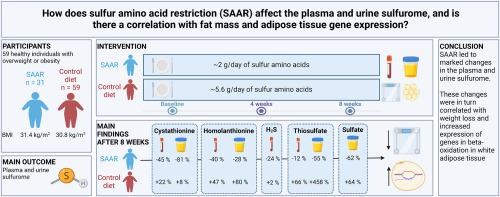当前位置:
X-MOL 学术
›
Redox Biol.
›
论文详情
Our official English website, www.x-mol.net, welcomes your feedback! (Note: you will need to create a separate account there.)
Dietary sulfur amino acid restriction in humans with overweight and obesity: Evidence of an altered plasma and urine sulfurome, and a novel metabolic signature that correlates with loss of fat mass and adipose tissue gene expression
Redox Biology ( IF 10.7 ) Pub Date : 2024-05-17 , DOI: 10.1016/j.redox.2024.103192 Thomas Olsen 1 , Kathrine J Vinknes 1 , Kristýna Barvíková 2 , Emma Stolt 1 , Sindre Lee-Ødegård 3 , Hannibal Troensegaard 1 , Hanna Johannessen 4 , Amany Elshorbagy 5 , Jitka Sokolová 2 , Jakub Krijt 2 , Michaela Křížková 2 , Tamás Ditrói 6 , Péter Nagy 7 , Bente Øvrebø 8 , Helga Refsum 9 , Magne Thoresen 10 , Kjetil Retterstøl 11 , Viktor Kožich 2
Redox Biology ( IF 10.7 ) Pub Date : 2024-05-17 , DOI: 10.1016/j.redox.2024.103192 Thomas Olsen 1 , Kathrine J Vinknes 1 , Kristýna Barvíková 2 , Emma Stolt 1 , Sindre Lee-Ødegård 3 , Hannibal Troensegaard 1 , Hanna Johannessen 4 , Amany Elshorbagy 5 , Jitka Sokolová 2 , Jakub Krijt 2 , Michaela Křížková 2 , Tamás Ditrói 6 , Péter Nagy 7 , Bente Øvrebø 8 , Helga Refsum 9 , Magne Thoresen 10 , Kjetil Retterstøl 11 , Viktor Kožich 2
Affiliation

|
In animals, dietary sulfur amino acid restriction (SAAR) improves metabolic health, possibly mediated by altering sulfur amino acid metabolism and enhanced anti-obesogenic processes in adipose tissue. To assess the effects of SAAR over time on the plasma and urine SAA-related metabolites (sulfurome) in humans with overweight and obesity, and explore whether such changes were associated with body weight, body fat and adipose tissue gene expression. Fifty-nine subjects were randomly allocated to SAAR (∼2 g SAA, n = 31) or a control diet (∼5.6 g SAA, n = 28) consisting of plant-based whole-foods and supplemented with capsules to titrate contents of SAA. Sulfurome metabolites in plasma and urine at baseline, 4 and 8 weeks were measured using HPLC and LC-MS/MS. mRNA-sequencing of subcutaneous white adipose tissue (scWAT) was performed to assess changes in gene expression. Data were analyzed with mixed model regression. Principal component analyses (PCA) were performed on the sulfurome data to identify potential signatures characterizing the response to SAAR. SAAR led to marked decrease of the main urinary excretion product sulfate (p < 0.001) and plasma and/or 24-h urine concentrations of cystathionine, sulfite, thiosulfate, HS, hypotaurine and taurine. PCA revealed a distinct metabolic signature related to decreased transsulfuration and HS catabolism that predicted greater weight loss and android fat mass loss in SAAR vs. controls (all p < 0.05). This signature correlated positively with scWAT expression of genes in the tricarboxylic acid cycle, electron transport and β-oxidation (FDR = 0.02). SAAR leads to distinct alterations of the plasma and urine sulfurome in humans, and predicted increased loss of weight and android fat mass, and adipose tissue lipolytic gene expression in scWAT. Our data suggest that SAA are linked to obesogenic processes and that SAAR may be useful for obesity and related disorders. .
中文翻译:

超重和肥胖人群的饮食含硫氨基酸限制:血浆和尿液硫组改变的证据,以及与脂肪量减少和脂肪组织基因表达相关的新代谢特征
在动物中,膳食含硫氨基酸限制(SAAR)可以改善代谢健康,这可能是通过改变含硫氨基酸代谢和增强脂肪组织中的抗肥胖过程来介导的。评估 SAAR 随着时间的推移对超重和肥胖人群血浆和尿液 SAA 相关代谢物(硫磺组)的影响,并探讨这些变化是否与体重、体脂和脂肪组织基因表达相关。 59 名受试者被随机分配至 SAAR(∼2 g SAA,n = 31)或对照饮食(∼5.6 g SAA,n = 28),其中包含植物性天然食品并补充胶囊以滴定 SAA 含量。使用 HPLC 和 LC-MS/MS 测量基线、第 4 周和第 8 周血浆和尿液中的硫磺代谢物。对皮下白色脂肪组织 (scWAT) 进行 mRNA 测序以评估基因表达的变化。使用混合模型回归分析数据。对硫组数据进行主成分分析 (PCA),以确定表征 SAAR 响应的潜在特征。 SAAR 导致主要尿排泄产物硫酸盐 (p < 0.001) 以及胱硫醚、亚硫酸盐、硫代硫酸盐、HS、亚牛磺酸和牛磺酸的血浆和/或 24 小时尿液浓度显着降低。 PCA 揭示了与转硫作用和 HS 分解代谢减少相关的独特代谢特征,预测 SAAR 与对照组相比,体重减轻和机器人脂肪量减少更大(所有 p < 0.05)。该特征与三羧酸循环、电子传递和 β-氧化中基因的 scWAT 表达呈正相关 (FDR = 0.02)。 SAAR 导致人类血浆和尿液硫组的明显改变,并预测体重和机器人脂肪量的减轻以及 scWAT 中脂肪组织脂解基因表达的增加。我们的数据表明,SAA 与肥胖过程有关,并且 SAAR 可能对肥胖和相关疾病有用。 。
更新日期:2024-05-17
中文翻译:

超重和肥胖人群的饮食含硫氨基酸限制:血浆和尿液硫组改变的证据,以及与脂肪量减少和脂肪组织基因表达相关的新代谢特征
在动物中,膳食含硫氨基酸限制(SAAR)可以改善代谢健康,这可能是通过改变含硫氨基酸代谢和增强脂肪组织中的抗肥胖过程来介导的。评估 SAAR 随着时间的推移对超重和肥胖人群血浆和尿液 SAA 相关代谢物(硫磺组)的影响,并探讨这些变化是否与体重、体脂和脂肪组织基因表达相关。 59 名受试者被随机分配至 SAAR(∼2 g SAA,n = 31)或对照饮食(∼5.6 g SAA,n = 28),其中包含植物性天然食品并补充胶囊以滴定 SAA 含量。使用 HPLC 和 LC-MS/MS 测量基线、第 4 周和第 8 周血浆和尿液中的硫磺代谢物。对皮下白色脂肪组织 (scWAT) 进行 mRNA 测序以评估基因表达的变化。使用混合模型回归分析数据。对硫组数据进行主成分分析 (PCA),以确定表征 SAAR 响应的潜在特征。 SAAR 导致主要尿排泄产物硫酸盐 (p < 0.001) 以及胱硫醚、亚硫酸盐、硫代硫酸盐、HS、亚牛磺酸和牛磺酸的血浆和/或 24 小时尿液浓度显着降低。 PCA 揭示了与转硫作用和 HS 分解代谢减少相关的独特代谢特征,预测 SAAR 与对照组相比,体重减轻和机器人脂肪量减少更大(所有 p < 0.05)。该特征与三羧酸循环、电子传递和 β-氧化中基因的 scWAT 表达呈正相关 (FDR = 0.02)。 SAAR 导致人类血浆和尿液硫组的明显改变,并预测体重和机器人脂肪量的减轻以及 scWAT 中脂肪组织脂解基因表达的增加。我们的数据表明,SAA 与肥胖过程有关,并且 SAAR 可能对肥胖和相关疾病有用。 。
















































 京公网安备 11010802027423号
京公网安备 11010802027423号